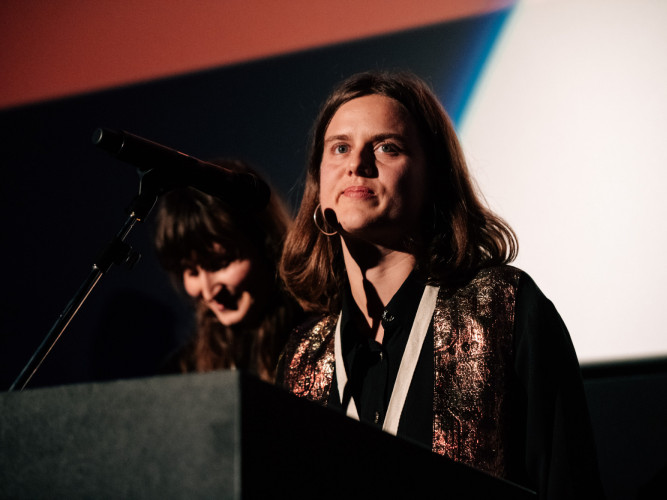Commemoration, identity, family relationships, and borders in the geographical and mental sense – these are four momentous and highly complex themes in a country like Israel. The short films in the Country in Focus: Israel explore issues that illuminate the history and present of this still young nation: the historic premises of its existence, the ubiquitous conflicts on multiple fronts, the militarization of everyday life, and family relationships within this environment. The threat of war after war, curiosity about and sometimes identification with the «enemy», and questions about the significance of religion have shaped Israeli cinema, especially since the beginning of the new millennium. Next to Joseph Cedar, Ari Folman, Amos Gitai, and Nadav Lapid, one of the most uncompromising filmmakers in this respect has been Avi Mograbi, and unlike many of his (similarly) successful colleagues, he continues to make shorts as well as features. In «Detail 2 & 3», he shows two versions of the well-known checkpoint scene, which has become a central image of the conflict between Israelis and Palestinians thanks to news reports. By forcing the soldiers to react and even yelling at them, the filmmaker transgresses the boundaries of an observing documentary – he becomes an actor within the action, which is additionally fuelled by the camera. Since the 1970s, Israeli cinema has increasingly addressed the state’s official politics and warfare with critical candour, and many recent works since 2007 have attracted considerable international attention, among them «Lebanon», «Waltz with Bashir», «Foxtrot», «Ajami», and series such as «Chatufim/Homeland» and «Fauda». While these features and series mostly take a relatively classical narrative approach, the short films presented here often push the boundaries of film genres. In addition, they explore the potentials of new digital media as creative sources, for instance Google Maps or Tinder («Unrendered Road», «The Men behind the Wall»). Digital reconstructions of the Auschwitz-Birkenau death camp, in turn, open new avenues for historiography, legal processes, and ideas about reincarnation («Another Planet»).
Concurrently with digitalization, the Israeli short film industry also demonstrates an intense scrutiny of analogue material. Interestingly, the first films made in the state – and even before the nation’s founding – were also shorts: documentary footage. After «Départ de Jérusalem en fer», which the Lumiere brothers produced during the Ottoman era, the period through the 1950s was dominated by ethnographic footage of Christian pilgrims, on the one hand, and short films commissioned by Zionist organizations, on the other, with the latter emphasizing the need for a safe Jewish state in the wake of World War II. Immigrants from the Soviet Union such as Nathan Axelrod and Brits like Murray Rosenberg and Thorold Dickinson created the image of the new, proud Hebrew man – a masculine hero (removed from the shtetl). Memories of this metaphor are found in the 16 mm reels of the Lehi movement, which Nir Evron’s «Belated Measures» renders in digital form, contemplating the tensions between documentation, reenactment, and fiction.
The questioning of national narratives is a recurring motif in Israeli filmmaking. Divergent stories and explanations crystallize at symbolically charged locations, such as the building on Rothschild Boulevard in Tel Aviv, where Ben Gurion declared the nation’s independence, or in objects like the ones Yael Bartana stages in her art videos. A trip to Israel’s miniature park («My Little Country»), in turn, is reminiscent of Matthias von Guntens unforgettable Swiss journey in «Reisen ins Landesinnere». One thing the narrative of the strong new Hebrews long suppressed was the trauma of Jewish immigrants who had either escaped persecution or survived the Shoah in hiding or in a concentration camp. The Eichmann trial played an important role in allowing public discussion of these experiences. The mass murderer was sentenced to death – but his ashes had to be taken outside the country: «Nacht und Nebel», an obvious allusion to Alain Resnais’ «Night and Fog», shows the distant echo of this event, like a coda.
Private photos and old home movies have become a popular source material in documentaries worldwide, linking family history with collective history. A recent example that was widely seen internationally is the Israeli-German production «Die Wohnung» by Arnon Goldfinger. Short films have also employed this type of research, and Meshy Koplevitch («73») and Rotem Dimand («The Silhouette of Braids») are among the young filmmakers addressing the past of their father and mother, respectively. After the LGBTQ scene, which has entered the Israeli mainstream since 2002 with films by Eytan Fox and Tomer Heymann, women are also staking out their place in Israel’s still male-dominated art and society. At the same time, the family unit in general increasingly yields to a focus on mother-daughter relationships. Women are under a lot of pressure, as they are still primarily expected to be or become good mothers. Meanwhile, the possibility of a lesbian life («Bracha», «One of Us Now»), for instance, tends to be ignored or considered irrelevant.
Bettina Spoerri
Replay MemoryHumans have always been fascinated by history. We search for traces of the past; we collect, analyse, interpret them. We try to make sense of the past, we want to understand and come to terms with it. The three films in Replay Memory use very different materials and approaches to explore Israel’s history.
«Belated Measures» by Nir Evron is based on rare footage from the archives of the paramilitary underground organization Lehi (Lohamei Herut Israel: Fighters for the Freedom of Israel), which was active during the British Mandate for Palestine. The footage analysed by the filmmaker is partly documentary in nature, partly, it was staged by Lehi. Evron reveals details about his research and shares his observations and speculations, discussing the relationship between war and photography, documentation and propaganda, visual traces and destruction. What is the significance of historical evidence in the moment of its interpretation? What role does the zeitgeist play, and to what extent is history malleable?
«Tashlikh (Cast Off)» by Yael Bartana references the Jewish new year’s custom of throwing breadcrumbs into a body of water to ask God for forgiveness for one’s sins. In her artistic work, Bartana often explores how collective memory shapes Israel’s sense of national identity. Identity is not stable but constantly in flux, subject to redefinition. The filmmaker invited both victims and perpetrators of the Holocaust, the Armenian genocide, and the ethnic cleansings in Sudan and Eritrea to dispose of material possessions connected to their traumatic past. In the film, these objects are falling in slow motion, at varying speeds, against a black background, some individually, some in groups. The images are accompanied by a hypnotic soundtrack, interrupted by moments of silence. A meditative and powerful way of processing the past and overcoming trauma.
With «Another Planet», Amir Yatziv presents an animated documentary about virtual models of Auschwitz, questioning the relationship between reality and digital worlds. The film follows the creators of these simulated worlds and explores the obsession with representing the Holocaust: a journey into the depths of memory and the human fascination with reconstruction and documentation. The virtual simulations were created for a variety of reasons: a German prosecution department designed a simulation to investigate a 94-year-old defendant; a 27-year-old Israeli software developer is inspired by his belief in reincarnation and aims to reconstruct his former life in a «Sonderkommando»; a German architect who has been measuring the camp for 15 years builds a high-precision computer model in collaboration with an Israeli historian. We follow the avatars of these creators through their respective virtual versions of Auschwitz. Do computer-based models offer new opportunities for representing memory and coping with trauma?
As different as these films are, together they offer a well-rounded image of approaches to history, using events that are crucial to the history of Israel.
Curated by John Canciani and Gabriela Seidel-Hollaender
with the kind support of: 













